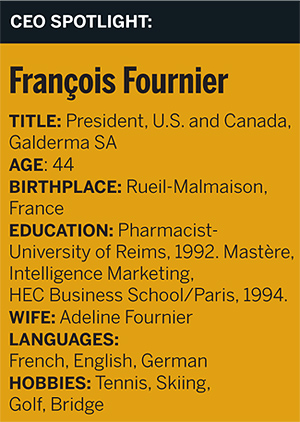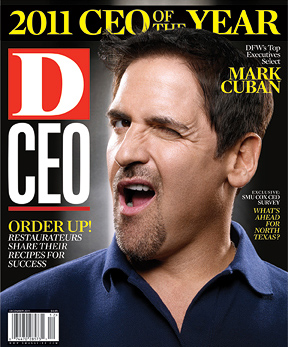Galderma, which has a 7.5 percent share of the worldwide market in its specialty, spends roughly $200 million a year in research. “This is fundamental research, where you start working with a molecule that might be promising,” he says. The company’s primary research center is located near Nice, France. It also has the R&D unit in New Jersey, and partners on research projects with a number of U.S. universities, including the University of Texas Southwestern Medical Center and Baylor University.
“From the time we have a molecule to the day it might be on the market typically is about 10 years,” he says.

The company’s Cetaphil line of skin moisturizers and cleaners has a longer history, with the first known use of the name dating back to 1945, Fournier says. “We take a very medicalized approach with Cetaphil. It’s more like a treatment,” he says of the fragrance-free products. “We give you a prescription for your eczema and you can also go to the store and buy a Cetaphil product that will help you, too.”
Galderma uses a variety of strategies to increase sales. “It’s not just one thing. You are doing many things,” Fournier says. Like other drugmakers, Galderma markets directly to patients with product commercials on TV and public service-type ads such as one encouraging teens with acne to seek help at a dermatologist.
Earlier this year, Fournier hired 10 people to form a merchandising team that visits drugstores and other outlets and checks shelves to make sure products are properly stocked and displayed. “I can have the best product but, if you can’t find it at CVS, you will be upset,” he says.
Another approach attracted the attention of the Harvard Business Review in June. It used Galderma’s sale of Epiduo, a prescription acne gel, as a case study for an article titled, “Competing Against Free.” The article points out that Galderma was under pressure to build the drug’s U.S. market because its other acne product, Benzac, was losing patent protection. Adding to the company’s challenges, a competing gel produced by GlaxoSmithKline PLC was providing stiff competition in Europe.
Expecting similar competition in the U.S., Galderma implemented a program to reimburse a patient’s out-of-pocket costs for as long as a year. In exchange for rebate coupons, customers gave the company their e-mail addresses, allowing Galderma to market to them with special offers for its non-prescription products, such as Cetaphil cleansing bars, the study pointed out.
According to the review, GlaxoSmithKline refused to match Galderma’s rebate, which allowed Galderma to gain customers and profitably cross-sell its over-the-counter products. The review suggested that GlaxoSmithKline should have matched Galderma, leaving it in the uncomfortable position of discounting its product without growing share.
Fournier says it’s not uncommon for drug companies to offering various discounts on new products to build business in a tough economy. Typically these are in the form of cards covering the patient’s insurance co-payment, which are distributed through physicians. Although he says he was flattered that Harvard chose Galderma for its case study, Fournier says the company tends to discount less than its competitors.
“My team will tell you, ‘François is lukewarm to using co-pay cards,’ ” he says.
“Nobody can ignore the cost of developing the drug. It’s huge,” Fournier continued, pointing out that regulators today require clinical studies for product registration on 5,000 patients, five times the number required 10 years ago. “I’m not being judgmental. It’s just a fact.”
Fournier says he prefers building “real value” by investing in research and development of the best drugs and products, and educating doctors about their use and benefits. “When you buy a Mercedes you know it has a cost. If it’s offered for free, long-term, you’ll be asking, `Is this really a Mercedes? Is it the quality car I was expecting?’
“If you are in my seat, you can boost sales in the short term by offering for free, but you don’t build the future,” he says.
America’s diffuse managed care system, where medical insurance coverage varies from state to state and insurer to insurer, “is the thing I think about the most when I’m driving home from work,” he says. “It is, in our jargon, market access. I have a managed care team in constant contact with insurers, big time. It’s our biggest challenge now and in the future.”
For future growth, the company is looking toward what Fournier called “aesthetic dermatology,” which he describes as the industry’s fastest-growing segment. “As people are growing older … they want to look as good as they did in the past,” Fournier says.
Late last year, Galderma purchased Sweden-based Q-Med AB, which makes products that smooth wrinkles and enhance breasts. Fournier points to his new hometown as proof of the burgeoning market demand for youthful looks.
It’s proof as well that he’s caught on to one of the defining folkways of his current posting. “Dallas is a good example [of] where women and men want to look good,” he says. “You can’t do all of it by yourself. You go to the dermatologist or plastic surgeon to help you look as young as you like.”






